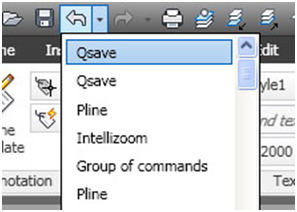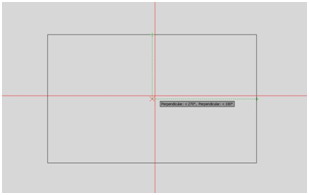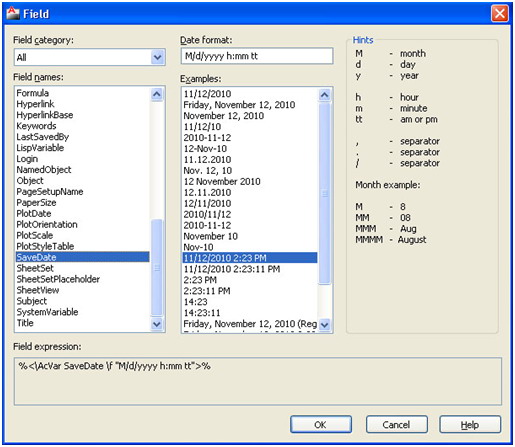TIPniques: A Few of My Favorite Things
In this month's TIPniques, I'm going to address some of my favorite AutoCAD commands, features, and settings. All of these features have many applications and ways that they can be applied into your daily workload.
Undo
One time at an Autodesk event we were asked what our favorite AutoCAD command was. Without hesitation I was able to answer "Undo." The people I was speaking with seemed surprised. In order to help me make my argument, take a few seconds to look up Undo in AutoCAD Help. The first thing it says about the UNDO command is: See Also – Correct Mistakes. That's my kind of command! I often make mistakes, so I use the Undo command throughout the day. I just wish AutoCAD could automatically detect when I make a mistake and automatically fix it for me. There are several ways to use the Undo command. You can type UNDO on the command line, jus the letter U, or click the Undo Arrows in the Quick Access toolbar. Fully typing out UNDO brings up the Undo options, giving you more choices and thus more ways to use Undo. The Undo Arrow lists the actions that you can undo. This lets you undo more than the last action.

Figure 1: The Undo Arrows are found in the Quick Action Toolbar. Picking the Down Arrow opens a list of most recent actions that can be undone.
Osnap tracking
Osnaps are fantastic. They ensure we draw accurately. Running Osnaps save us time by activating the Osnaps automatically. Osnap Tracking gives the cursor the ability to track along alignment paths based on other Osnap points. It gives you the ability to find points without having to draw construction lines. It saves time and effort while keeping your drawing clean. You can toggle it on or off by pressing the F11 key. If you look at Figure 2, you will see a rectangle. In this drawing I have the Midpoint Running Osnap turned on as well as Osnap Tracking. I start the line command because I want to draw a line from the center of this rectangle. I hover my mouse over the midpoint of the top horizontal line allowing the osnap to "capture" the midpoint. A green tick mark is placed there. I hover over the midpoint of the right side the rectangle getting the Midpoint Osnap again. I move the cursor towards the center of the rectangle and my Osnap Tracking extends the intersection of these two points picking the center of the rectangle. I pick that point and go on about my business. I did little work, drew no more lines than needed, and I don't have to clean up my drawing. Good work.

Figure 2: Osnap Tracking finds my Osnap points and extends them out through an alignment path.
Construction Lines/Rays
When drafting, a designer will use construction lines to help in the creation of their model. AutoCAD has two object types that will help: Construction Lines and Rays. Both work the same way but there is a slight difference between them. An AutoCAD Construction Line Object draws a line that extends to infinity in both directions. An AutoCAD Ray object extends in one direction to infinity. The best thing is that these lines extend out indefinitely, but if you perform Zoom Extents, you won't zoom out to infinity, just to the drawing's limits or extents. These two objects can be manipulated as if they were lines. You can put them on a layer, change their properties, trim them, move them, copy them, or anything else that you would do to a line object. Once they are trimmed or broken they magically turn into line objects. They are a handy way to create construction lines or drafting aids in your drawings.
Fields
How do you automate information in AutoCAD? Fields. If an AutoCAD object or file has a value or setting, a field can display it. A field can be utilized in any annotation object - single text, multiline text, dimensions, tables, dimensions or even leaders. While in the text editor for the appropriate annotation type, press CTRL+F to insert a field. A window (similar to Figure 3) will open providing you with a host of options. Depending on the type of information you want to display, browse to that data type, be it from a Sheet Set, an Object, an AutoCAD System variable, date, or more.
If you pick the object type, then you will be able to display information about any object in your file. If you need to show the length of a line, select that line, the pick the length option. If you want to display the area of a room in your building, pick a closed shape that encompasses that room and pick its area. That shape could be a closed polyline, a rectangle, a boundary, or even a hatch.
Use fields for plot stamps or title block information. You can create a text object that uses fields to read the files name, network location, the current user, the paper space tab, and the time the file is being printed. If you are using Sheet Sets (which you really should be doing) then use fields to get the Sheet Set information into your drawing. There are three sections for Sheet Sets. Add a custom property to your sheet sets for data that needs to show up on many drawings, like a control elevation or material spec. Everywhere in your set that you need to display that data, use a field to display the Sheet Set Property. That way if the material changes you only have to edit it once and every drawing will be updated without ever opening the files.

Figure 3: Click to enlarge. Fields can display information about any object or setting in AutoCAD.
CTRL+S/CTRL+C/CTRL+V/CTRL+SHIFT+V
If you are using AutoCAD for Windows, then your typical Windows shortcut keystrokes will also apply to AutoCAD. That means pressing the CTRL key with other keystrokes will do things in AutoCAD. I have a motto: "Save early, save often." Computers fail, crash, burp, and just act as if they are possessed sometimes. You never want to lose your data. The best way to prevent this is to save your work frequently. AutoCAD has a Qsave command that will save your file for you, replacing the old version. If you press CTRL+S AutoCAD will execute a Qsave. It’s easy to do and right on your keyboard. You can do it with one hand.
Windows also allows you to use the Copy/Paste features of its clipboard. You can right-click on an object or objects and pick the Copy or Paste options; or you can select your objects and press CTRL+C to copy, then CTRL+V to paste. This is very useful when copying linework from one AutoCAD file to another. This was a great new tool when we switched from DOS to Windows. (Yes, I'm that old.) You might have known this trick, but did you know that if you press CTRL+SHIFT+V you will paste your objects as a block? That can be very handy when working with several objects at one time. Plus it’s an easy way to make a block.
Conclusion
AutoCAD is a great tool. There are many functions and commands in it that can make our lives easier. Finding new and better ways to use the tools available is one of the challenges - and delights - of being an AutoCAD user.
Brian C. Benton is a CAD technician and designer located in Fort Myers, Florida. Brian has been working with AutoCAD since release 10 in the mechanical, structural, and civil engineering fields. He has been a detailer, drafter, designer, IT assistant, CAD software manager, protector of standards, and proverbial "Help Desk." Brian is currently one of Cadalyst magazine's "Tip Patrollers." He can be reached at bbenton@cad-a-blog.com. His blog can be found at: http://CAD-a-Blog.com